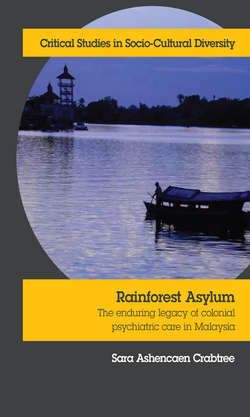Читать книгу Rainforest Asylum - Sara Ashencaen Crabtree - Страница 9
На сайте Литреса книга снята с продажи.
1 Introduction
ОглавлениеIn 1996, fresh from university studies, I was delighted to leave a wintry Britain to take up my first academic post in Malaysia – a compellingly fascinating region. My first experience of Malaysia was the congested capital city of Kuala Lumpur, where bristling, hyper-modern skyscrapers towered over the more sedate, colonial villas and municipal landmarks, thus defying many of my more outdated notions of the city. Finally, I arrived in Sarawak, East Malaysia, which I found both beautiful and sufficiently steeped in a polymorphous and multifaceted heritage to satisfy my romantic instincts and where I lived very happily for the next five years. Settling in at the local university I subsequently learned probably as much from my friendly, multicultural Malaysian students as I taught them of the social sciences.
At some point during those first exciting, confusing and frenetic months of orientation I became aware of the existence of a discreetly located psychiatric hospital built some sixty or so years earlier. I had long been interested in mental health issues and resolved to learn more about mental health provision in this area at the first opportunity. As I settled into my new life, it became apparent that the hospital had been virtually untouched by previous external research, and yet appeared to offer an intriguing picture of post-colonial psychiatric care that invited closer attention.
After making some initial overtures to the hospital authorities, I was eventually sufficiently privileged to be permitted to carry out a series of research studies at the hospital, which for the purposes of confidentiality, whilst trying to remain true to the appellations of many psychiatric hospitals in Malaysia, I have duly called ‘Hospital Tranquillity’. This book, the culmination of my research studies there, represents a pioneering experience for me in view of the dearth of research activities taking place on such topics regionally.
Moreover, the few studies undertaken on mental health issues in Malaysia have mostly been scientifically based. Therefore, being quantitative in methodology, they have not focused upon subjective experiences, particularly those of psychiatric patients, which incontestably formed a serious deficit in our understanding of mental health phenomena. A gap in the literature, therefore, was evident. Thus the study, after duly negotiating logistical problems and the potential quagmires of ethics committees, commenced in 1997. Reaching a zenith in the new millennium, it was periodically dusted down in the intervening years. Now fully revived and revised, this ethnography offers an account of the lives of both patients and staff in a post-colonial psychiatric institution in Malaysia. In so doing it has drawn from a particularly influential well of knowledge – the surge of interest by historians in colonial psychiatry – which has illuminated many of the phenomena noted in this study; and which may be seen to make its own tangential contribution to our dislocated understandings of historically situated care.
*
The aim of the ethnographic approach, which is the chosen form of methodology used here, links the narratives of participants to the overarching theme relating to the embedded nature of the colonial paradigms of the asylum, which, it is argued, are implicitly enacted at Hospital Tranquillity. Ethnography enables the researcher to engage closely with a complex social situation. It is the pursuit of understanding of the ‘culture’ of the setting through an analysis of the conditions of individuals therein, premised upon and grounded in their experiences and perspectives. Accordingly, the concept of ‘culture’ defines how participants view their world, and interact with and from within it, using a phenomenological view. Here it serves to define the categories of participants: as ‘patients’ or ‘staff’ with implicit and explicit social guidelines that prescribe expected conduct for each group. Naturally, however, individuals frequently do not react or behave in the way that might be predicted from their acculturation (Helman, 1990). Consequently, the descriptions of participants across the institutional strata are noted in reference to their experiences of hospital life, albeit often from very different perspectives. The strong resonance between narratives and theory therefore seeks to lend a muscular and vigorous credibility to a critical discussion of postcolonial psychiatric services in contemporary Malaysia.
Furthermore, as will be discussed in more detail in Chapter Two, this study does not attempt to camouflage or obviate the mediating influences of my cultural background, but instead openly exploits this as a prism through which to interpret findings and my role as a researcher. My position as a British, white and female researcher therefore creates an interesting resonance in research undertaken in a developing country with a British colonial heritage, and is explored in greater depth.
Finally, I would add that, as this is a study of a unique phenomenon, it would be unwise to make gross generalisations across all psychiatric institutions in Malaysia or to assume that one psychiatric hospital is exactly the same as another (Brewer, 2000; Hammersley, 1990b). As will be seen however, the narratives of participants do raise important questions for contemporary services in this region, and serve to increase our awareness and comprehension of the development of mental health services in other postcolonial nations. Those services considered here are grounded in the historical context of colonialism in Malaya and its relationship with the advancing profession of psychiatry practised on subject nations. That many of these traditional, and often very oppressive, practices and attitudes can still be found in current service delivery is at least disquieting and demands closer scrutiny. Yet, the insights provided by analyses of colonial psychiatry suggest that there are some close parallels to be drawn in the evolutions of psychiatry between Malaysia and Britain in particular, and also across the other nations of the Commonwealth.
